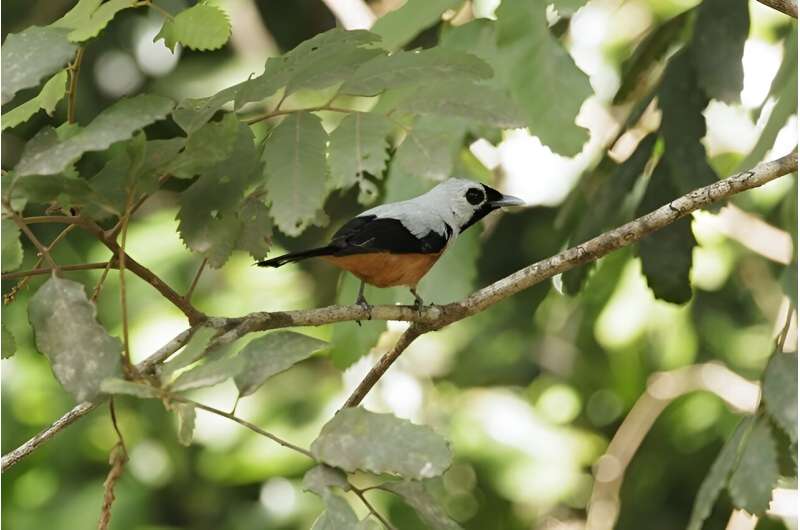This article has been reviewed according to Science X's editorial process and policies. Editors have highlighted the following attributes while ensuring the content's credibility:
fact-checked
trusted source
proofread
Tracking the migration adventures of Black-winged Monarchs

Black-winged Monarchs (Monarcha frater) are songbirds that live in the rainforests of New Guinea and northern Australia. They feed on insects and belong to the same bird family, Monarchidae, as flycatchers and magpie-larks.
One of the four subspecies of Black-winged Monarch, Monarcha frater canescens (or M. f. canescens for short), migrates to Australia to breed from November to March in the tropical forests of Far North Queensland.
When cooler temperatures arrive, M. f. canescens vanishes. Do these birds spend winter in New Guinea where the other subspecies live? The whereabouts of M. f. canescens during the non-breeding season is a mystery that scientists have pondered for more than 100 years.
A migration mystery
Dr. Leo Joseph, Director of our Australian National Wildlife Collection, studied specimens of Black-winged Monarch held in natural history collections to pinpoint the whereabouts of M. f. canescens during the non-breeding season.
The paper, "The Black-winged Monarch (Monarcha frater): Geographic variation, taxonomy, a 'new' population, and an enduring mystery in migration," by authors from CSIRO, American Museum of Natural History and Sicklebill Safaris, was published in Avian Research.
He said specimens held in collections reveal much more than the plumage and features of the species. "Specimens reveal the morphology of individuals, but they also record dates and location data, showing us exactly when an individual bird was present in a particular place," Leo said.
"For this study, we used 194 specimens of Black-winged Monarchs, which we think is the total number of this species held in the world's museums and collections."
As well as studying these 194 specimens, Leo and his collaborators used journal papers, photos published online and in books and recordings of bird song.
Despite their extensive study, they were unable to solve the mystery of where M. f. canescens migrate to when they leave their breeding range in Far North Queensland each March.
"We can be sure they go to New Guinea, but exactly where remains unknown," Leo said.
But their research did reveal a surprise among the four subspecies.
One species or many?
While looking at the 194 Black-winged Monarch specimens, the researchers had to consider the physical characteristics used to assign each bird to its subspecies. This would let them match M. f. canescens specimens from Queensland to any specimens from New Guinea.
They noticed the specimens don't fit well into four subspecies.
"Based on differences in the patterns of the feathers on their heads, we think there may actually be three species of Black-winged Monarchs, not one species divided into four subspecies," Leo said.
The team suggested names for the three kinds of Black-winged Monarchs. They are:
- Arfak Monarch (M. frater) for the birds living in the northwest of the island of New Guinea
- Masked Monarch (M. periophthalmicus) for the birds elsewhere in New Guinea
- Pearly Monarch for the birds that breed in Queensland and disappear somewhere into New Guinea when not breeding.
"Whether there truly are three separate species of Black-winged Monarchs is something that DNA analysis could resolve," Leo said.
An enduring mystery
Bird specimens in museums and collections are known as "study skins." Their bones and soft tissues have been removed and specimens stuffed with cotton wool in a process similar to taxidermy.
Only four of the 194 of the Black-winged Monarch specimens used in this study have frozen tissue stored for DNA analysis. But with recently developed DNA sequencing techniques, researchers can now extract DNA from the toe pad skin of bird specimens. Leo's team will use this technique to test their hypothesis that Black-winged Monarchs are actually three separate species.
"Bird taxonomy is complex. Genomic analysis is really the best way to resolve intricate evolutionary relationships in cases like these. But the mystery of where the Pearly Monarch goes when it leaves Queensland endures," Leo said.
Leo noted that GPS trackers would not be useful, in part because they would require capturing, releasing and recapturing the birds. Instead, field observers should pay careful attention to the head pattern of any individuals in southern central New Guinea.
"Knowing which birds live where is vital for conservation. To misquote Oscar Wilde, 'to lose a species is tragic; to not know where it is for half of every year is careless,'" he said.
More information: Leo Joseph et al, The Black-winged Monarch (Monarcha frater): Geographic variation, taxonomy, a "new" population, and an enduring mystery in migration, Avian Research (2023). DOI: 10.1016/j.avrs.2023.100122
Provided by CSIRO


















